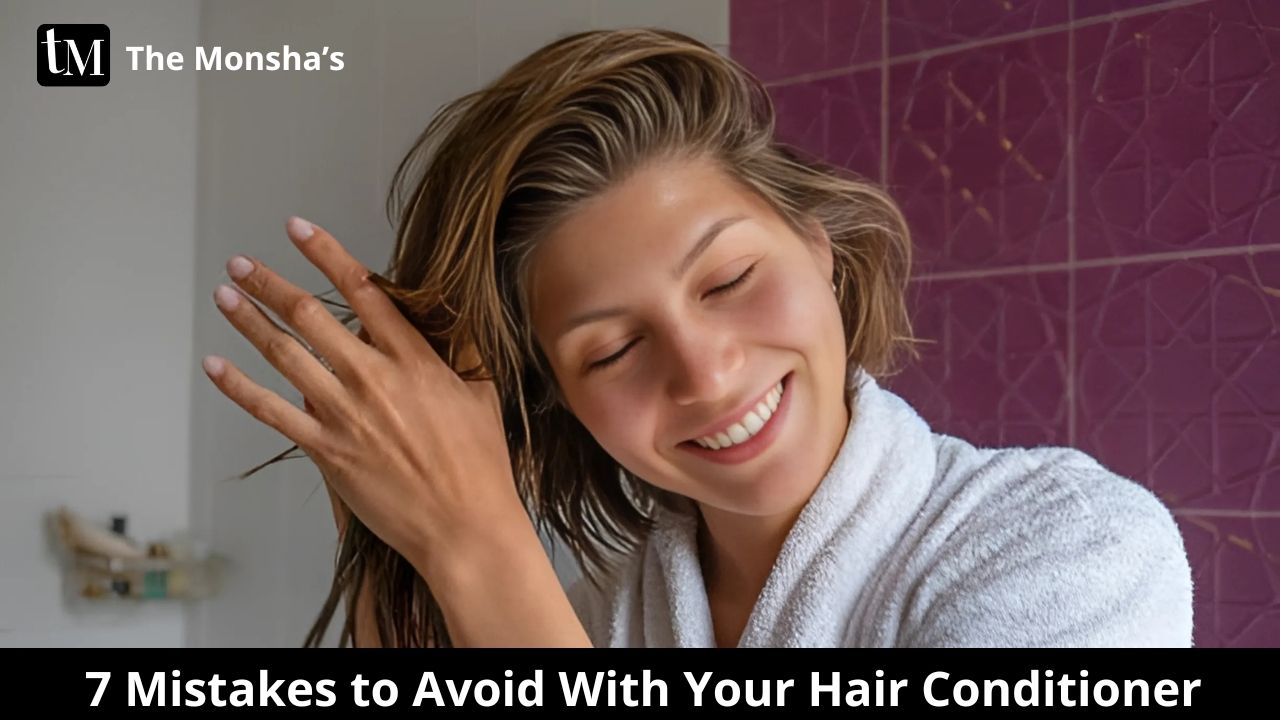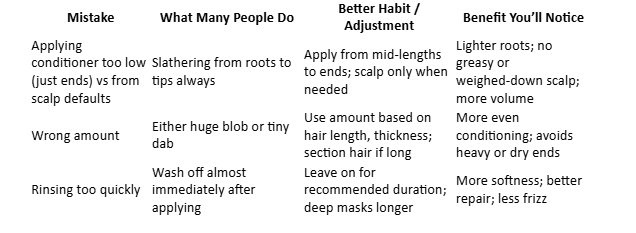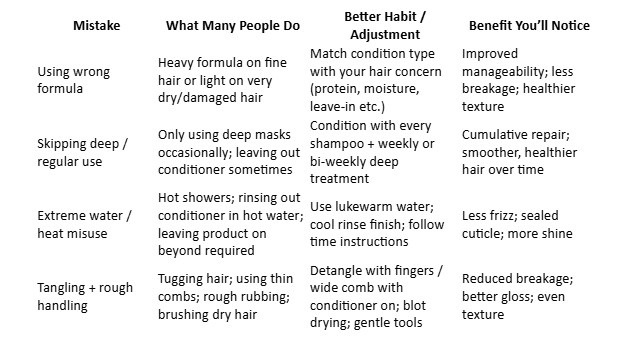
I spent way too many showers with conditioner feeling meh — hair flat, ends still frizzy, scalp oily, texture off. Turns out, it wasn’t the product always; sometimes, it was how I used it (or misused it). If you feel like your conditioner isn’t doing its job, this is your checklist of mistakes to ditch — plus what to do instead. Because using conditioner right really matters.
First: conditioning isn’t just “extra pamper time.” According to dermatologists and cosmetic-science reviews:
So yes, conditioner is essential — but only if used right. Let’s go through what people often mess up, and what you can change.
Why it’s a problem: The scalp naturally produces oils (sebum); layering conditioner there every wash can cause buildup, weigh roots down, make hair greasy & lifeless near the crown.
Better way: Apply conditioner from about mid-length to ends. If your scalp is very dry or flaky, you can use a lightweight or scalp-specific conditioner at the scalp, but not every wash. Use leave-in treatments or special drop-in formulas instead of rinse-out conditioner for scalp issues.
Why it’s a problem: Too much conditioner leads to residues that weigh down hair, hide shine, leave limp strands. Too little, and damage isn’t repaired, ends stay dry, cuticle remains raised.
Better way: Start with a moderate amount (for many hair types, one or two quarter-sized blobs), focus product on lengths/ends. For fine or short hair, less is more. For thick, long, curly hair, you may need more or to section hair so the product reaches all parts evenly.
Mistake 3: Not Leaving It On Long Enough (Or Rinsing Too Quickly)
Why it’s a problem: Conditioner ingredients need time to deposit, seal cuticles, add moisture, smooth strands. Rinsing too soon means most of the benefit is washed away.
Better way: Follow directions on the bottle. Usually leave-in for 1-5 minutes for typical rinse-out conditioners. Deep conditioners or hair masks need longer (sometimes 10-30 minutes, under heat or steam if available). Use a wide-tooth comb to distribute, then rinse with lukewarm water, finishing with cool water if possible to help seal cuticle.
Why it’s a problem: Hair texture, porosity, damage, oiliness all determine what kind of conditioning your hair needs. Using heavy protein-rich or oil-rich formulas on fine / oily hair can lead to weight; using light formulas on very dry or damaged hair will not repair enough.
Better way: Identify your hair type (fine, medium, coarse; straight, curly; damaged vs healthy). Pick conditioners accordingly: lightweight / volumizing for fine/oily; rich / moisture-deepening for dry or curly; protein treatment for chemically or heat-damaged; colour-safe formulas if dyed. Rotate if needed (heavy formula when hair is stressed; lighter one otherwise).
Why it’s a problem: Many people only use masks occasionally or skip conditioner sometimes to save time. But regular conditioning (every wash or at least frequently), plus periodic deep treatments, is what keeps hair resilient and healthy. Without it, damage accumulates and becomes harder to fix.
Better way: Condition every time you shampoo (unless your hair gets very oily and you shampoo seldom; in that case, at least condition lengths). Use a deep conditioner or hair mask once a week or every few washes for extra repair (especially if you use heat tools, color, etc.).
Why it’s a problem: Leaving rinse-out conditioner on too long isn’t always helpful; sometimes it can overload strands or cause product buildup. Rinsing with very hot water can lift cuticles and lead to frizz or damage; cold water rinses help smooth cuticle but shock not always suitable depending on hair state.
Better way: Leave a rinse-out conditioner only for recommended time. For deep treatments, follow label, sometimes cover with cap or use steam or warm wrap. Rinse with lukewarm water, then maybe a final cool rinse to flatten cuticle and add shine. Avoid super hot showers or scrubbing hair under water.
Why it’s a problem: Tangled hair causes breakage, uneven application of conditioner, leads to rough texture, frizz. If conditioner isn’t worked through and detangled, some parts remain untreated or damaged. Also, wrong tools (thin brush, rough towel) cause damage.
Better way: After shampoo, gently squeeze out excess water. Use fingers or a wide-tooth comb when conditioner is on to detangle from ends toward roots. Use soft towel or microfiber to dry (blot, not rub). Comb hair only when conditioned or leave-in applied. Also avoid rubbing scalp harshly.


How to Check If Your Conditioner Is Working
Here’s how to know whether you’re doing good or you need to adjust:
If after a few washes those don’t improve, revisit the mistakes above: amount, formula, contact time, technique.
Conditioner is not “step 3 if you feel like it” — it’s crucial. Using conditioner properly transforms how your hair behaves day-to-day. Fixing just one of these mistakes (say, stopping applying at roots or rinsing cooler) might already make your hair feel better. Start with one change, see what your hair does for itself, build on that. Your hair deserves that little extra intelligence in how you use products.